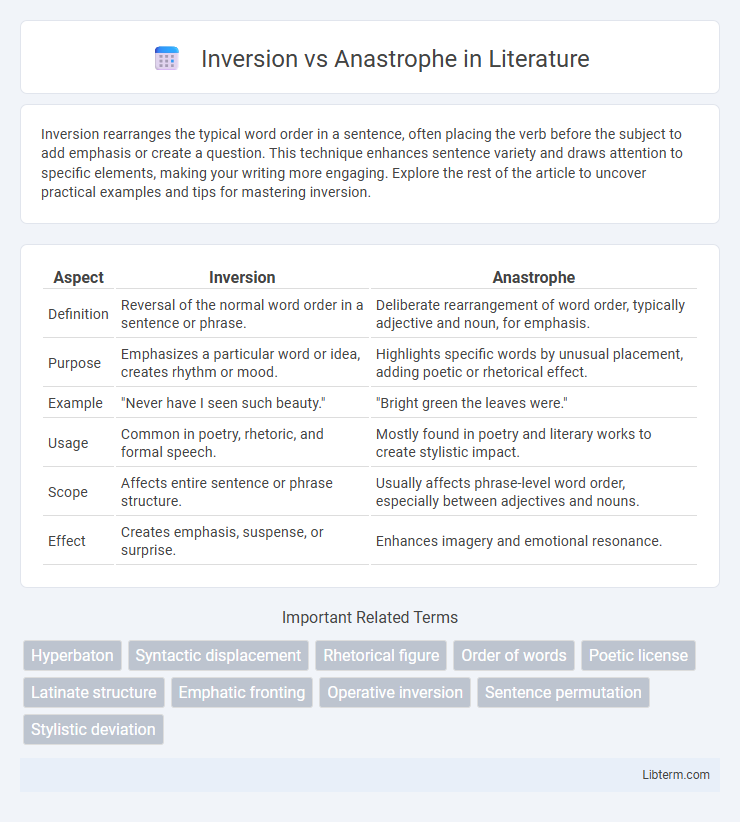Inversion rearranges the typical word order in a sentence, often placing the verb before the subject to add emphasis or create a question. This technique enhances sentence variety and draws attention to specific elements, making your writing more engaging. Explore the rest of the article to uncover practical examples and tips for mastering inversion.
Table of Comparison
| Aspect | Inversion | Anastrophe |
|---|---|---|
| Definition | Reversal of the normal word order in a sentence or phrase. | Deliberate rearrangement of word order, typically adjective and noun, for emphasis. |
| Purpose | Emphasizes a particular word or idea, creates rhythm or mood. | Highlights specific words by unusual placement, adding poetic or rhetorical effect. |
| Example | "Never have I seen such beauty." | "Bright green the leaves were." |
| Usage | Common in poetry, rhetoric, and formal speech. | Mostly found in poetry and literary works to create stylistic impact. |
| Scope | Affects entire sentence or phrase structure. | Usually affects phrase-level word order, especially between adjectives and nouns. |
| Effect | Creates emphasis, suspense, or surprise. | Enhances imagery and emotional resonance. |
Introduction to Inversion and Anastrophe
Inversion and anastrophe are stylistic devices used to alter the conventional word order in sentences, enhancing emphasis and poetic effect. Inversion typically involves reversing the subject-verb-object sequence to highlight a particular element, often found in Shakespearean or classical literature. Anastrophe specifically refers to the abnormal or reversed order of words, usually involving adjective-noun or prepositional phrase placements, creating a distinctive and memorable expression often employed in poetry and rhetoric.
Defining Inversion in Grammar
Inversion in grammar involves reversing the typical subject-verb-object order to emphasize a particular element or create a specific effect, such as in questions or conditional sentences. This syntactic structure is common in English interrogatives, where the auxiliary verb precedes the subject, e.g., "Are you coming?" Inversion differs from anastrophe, which typically refers to the more extensive rearrangement of word order for poetic or rhetorical impact rather than standard grammatical constructions.
Understanding Anastrophe in Linguistics
Anastrophe in linguistics refers to the deliberate reversal of the typical word order within a sentence to create emphasis or achieve a specific stylistic effect, often altering the conventional subject-verb-object sequence. Unlike general inversion, which frequently involves flipping subject and auxiliary verb for questions or emphasis, anastrophe can reposition any element within the sentence, such as placing adjectives after nouns or verbs before subjects. This syntactic manipulation enhances poetic or rhetorical impact by drawing attention to particular words or ideas in literary and conversational contexts.
Key Differences Between Inversion and Anastrophe
Inversion involves reversing the typical word order in a sentence to create emphasis or a poetic effect, such as placing the verb before the subject in English grammar. Anastrophe specifically refers to the deliberate rearrangement of word order, often adjectives and nouns, in a phrase to produce a stylistic impact, commonly seen in classical or poetic language. The key difference lies in scope: inversion alters sentence structure broadly, while anastrophe targets particular word pairs or groups for rhetorical effect.
Historical Usage of Inversion
Inversion, the syntactic reversal of normal word order, has deep historical roots dating back to classical Latin and Ancient Greek literature, where it enhanced rhetorical emphasis and poetic meter. Renaissance writers like Shakespeare popularized inversion in English drama and poetry to maintain iambic pentameter and highlight key themes. Historical usage of inversion spans centuries, serving as a versatile stylistic device to manipulate rhythm and focus in both prose and verse.
Anastrophe in Classic Literature
Anastrophe, a deliberate inversion of the typical word order, serves to emphasize specific elements and enhance the poetic quality of classic literature. This rhetorical device, frequently employed by Shakespeare and Homer, creates a rhythmic complexity that draws reader attention and deepens narrative impact. Its strategic use enriches character dialogue and vivid imagery, distinguishing classic texts through unique linguistic style.
Functions and Effects in Writing
Inversion rearranges the standard subject-verb-object order to emphasize a particular element, heightening dramatic effect or creating suspense in writing. Anastrophe specifically alters the normal word order within phrases, often placing adjectives after nouns, to produce a poetic or archaic tone that enhances memorability. Both techniques manipulate syntax to draw attention, affect rhythm, and influence the reader's emotional response.
Famous Examples of Inversion
Famous examples of inversion appear in Shakespeare's works, such as in "Macbeth," where the line "Fair is foul, and foul is fair" emphasizes contrast by reversing the typical word order. Inversion, distinct from anastrophe, rearranges the conventional syntax to highlight certain words or to maintain a metrical pattern. This technique is also prevalent in Milton's "Paradise Lost," where phrases like "Him the Almighty Power hurled headlong flaming" create emphasis through unusual word placement.
Notable Instances of Anastrophe
Notable instances of anastrophe appear frequently in classical literature, such as Yoda's speech patterns in Star Wars, where the normal word order is disrupted for emphasis and memorability. Shakespeare's plays also showcase anastrophe, particularly in lines like "Sweet are the uses of adversity," which rearranges words to enhance poetic rhythm and focus. This deliberate inversion distinguishes anastrophe from general inversion by its artistic and stylistic purpose.
Choosing Between Inversion and Anastrophe
Choosing between inversion and anastrophe hinges on the desired emphasis and rhythm in a sentence. Inversion rearranges the typical subject-verb-object order to highlight a particular element, commonly used in questions or poetic expressions, while anastrophe specifically involves transposing adjacent words, often adjective-noun pairs, to create a more pronounced or stylistic effect. Understanding the subtle distinctions allows writers to enhance clarity, tone, and impact tailored to their narrative or poetic objectives.
Inversion Infographic

 libterm.com
libterm.com